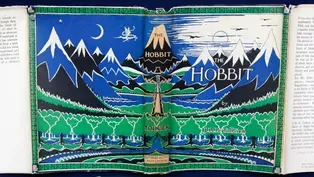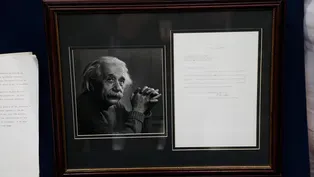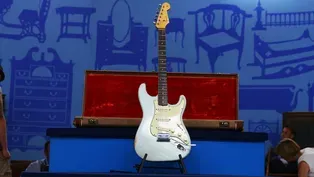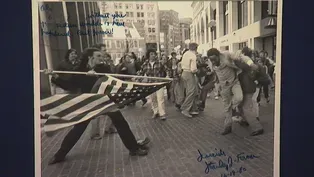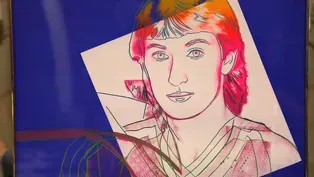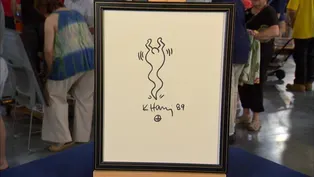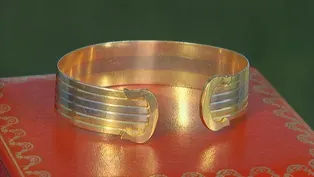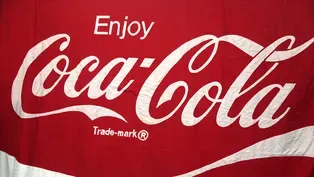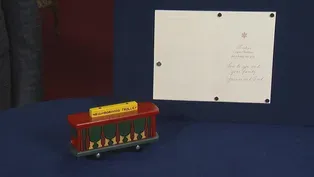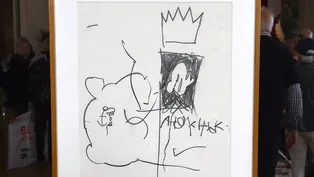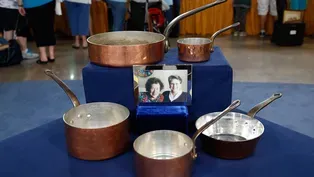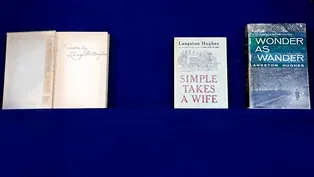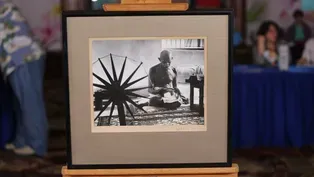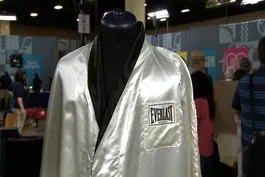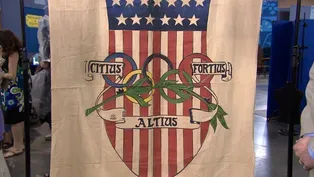
Modern Icons
Season 25 Episode 20 | 52m 30sVideo has Closed Captions
Celebrate influential icons with treasures like a $500,000 find!
Celebrate the influential icons of our collective and recent memory with treasures like a Jean-Michel Basquiat oil stick drawing, a Fred & Joanne Rogers trolley and card, and Julia Child's copper pans. Which has an updated value of $500,000?
Problems with Closed Captions? Closed Captioning Feedback
Problems with Closed Captions? Closed Captioning Feedback
Funding for ANTIQUES ROADSHOW is provided by Ancestry and American Cruise Lines. Additional funding is provided by public television viewers.

Modern Icons
Season 25 Episode 20 | 52m 30sVideo has Closed Captions
Celebrate the influential icons of our collective and recent memory with treasures like a Jean-Michel Basquiat oil stick drawing, a Fred & Joanne Rogers trolley and card, and Julia Child's copper pans. Which has an updated value of $500,000?
Problems with Closed Captions? Closed Captioning Feedback
How to Watch Antiques Roadshow
Antiques Roadshow is available to stream on pbs.org and the free PBS App, available on iPhone, Apple TV, Android TV, Android smartphones, Amazon Fire TV, Amazon Fire Tablet, Roku, Samsung Smart TV, and Vizio.
Buy Now
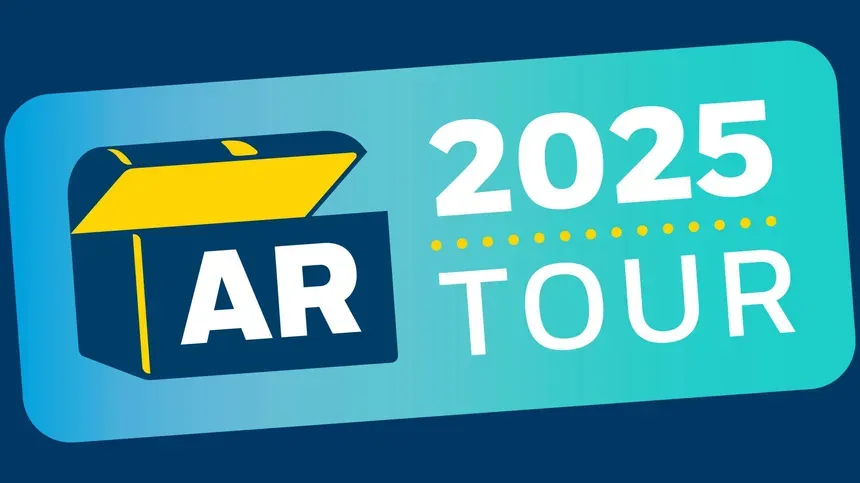
ANTIQUES ROADSHOW 2025 Tour!
Enter now for a chance to win free tickets to ANTIQUES ROADSHOW's 2025 Tour! Plus, see which cities we're headed to!Providing Support for PBS.org
Learn Moreabout PBS online sponsorship♪ ♪ CORAL PEÑA: We've got treasures with 20th-century influencers that are still inspiring us today.
Warhol specialized in taking celebrities and giving them this pop icon status.
I can't believe that.
PEÑA: It's "Antiques Roadshow: Modern Icons."
♪ ♪ In this hour of "Antiques Roadshow," we're highlighting legendary people who remain rooted in our collective memory.
APPRAISER: Well, Langston Hughes as you know, was one of the most famous poets and authors of the Harlem Renaissance.
PEÑA: As well as the artifacts of high-profile companies and creators that continue to be desired by collectors.
APPRAISER: A wonderful inscription.
APPRAISER: And it's just a beautiful flag.
Coke is one of the most iconic American brands, also is probably one of the most, longest collected brands.
APPRAISER: And then the actual signature of Tolkien on the half-title.
APPRAISER: The neighborhood trolley here, I mean, that's an iconic piece for... PEÑA: These icons, ideas, and contributions to society endure today, and so do the treasures connected to them.
Like this prize photo with two giants of professional baseball.
MAN: That's my father, and he was a baseball umpire.
And he still umpires at the age of 90.
APPRAISER: 90-- when did he start?
He started in 1946 when he was, I guess, 31 years old.
He did Major League games when the Big League teams came to Hawaii.
And how many teams came over the years?
Well, the Yankees came, the Dodgers came.
Cardinals.
So the big names.
The big names.
And you would occasionally go to the games.
I would always go to the games.
You would always go to the games.
(laughs) Which leads us to our second photo.
Okay.
Now, this had to be a special day for you.
This is you in the center, right?
Yes.
Jackie Robinson, by the way, giving you a very weird look here.
I mean, were you giving him a pinch?
I think he's giving Campy a weird look.
Ah.
And then Roy Campanella on the other side.
Right.
What's your memory of this day?
Well, my father said, "Meet me near the dugout before the game," and so I showed up and, and he opened the gate, called me in, and he said, "I want my boy to sit right here."
And it was right next to Jackie Robinson.
Wow!
What were you thinking?
I remember thinking, "God, does he have big biceps!"
(both laughing) What was he like?
Did he talk to you?
He didn't talk to me much, but it must have been a drag for him to have a ten-year-old kid sitting next to him the whole game.
But he did give me his bat.
And that, unfortunately, your parents threw away.
I can't believe it.
Uh...
They made a terrible mistake.
(laughs): They made a terrible...
But they didn't make a mistake here about getting a photo.
You and Campy and Robinson together.
And this was 1956?
It was '56.
Well, this is a great personal memory to you, but it's also a spectacular piece of baseball history.
Here you have the two trailblazers of integration: Jackie Robinson, who joined the Dodgers in '47.
Campy followed him a year later.
You know, they were among the first two African American ballplayers to make the All Star Team, in '49, with Don Newcombe and Larry Doby.
Campanella went on to win three MVP trophies.
Wow.
Robinson won one, in '49, and of course, the pinnacle of their careers, they defined the Brooklyn Dodgers in the 1950s, and they won the World Series in 1955.
Right, beating the Yankees.
Beating the Yankees, of course.
Right, right.
Which leads us really into value.
And it's kind of bittersweet here.
This is the last trip that Jackie Robinson ever took with the Dodgers.
Oh, I didn't know that.
Because when they returned, the Dodgers, after all he did, traded him to the Giants-- the New York Giants!
And Jackie Robinson could not live to, to play for the New York Giants-- he retired.
So you have one of the last photos of Jackie Robinson in a Dodgers uniform.
That I had not realized.
Now, the second thing, it's rare to ever see them sign a photo together, and it has perfect provenance.
We know the day it was taken!
I would place a conservative auction estimate of $6,000 to $8,000 on the photo.
Can't believe that.
And if, you know, if you're going to insure it, I'd insure it for at least $10,000.
So even photographs in which I appear have some value.
Well, their signatures were faked so much by their bat boy, Charlie "The Brow" DiGiovanni, that to have something where you can prove that you were there and they signed it for you, it's, it's provenance, it's authenticity.
I don't think Charlie made the trip.
Yeah, I don't think Charlie made the trip, either.
But this is not only a fabulous personal piece, memento to you, but it's a great snapshot of history.
Wow, thank you.
That's really wonderful, really wonderful.
I received it about five years ago as a gift from a former colleague of mine.
He was moving abroad and he couldn't take all of his furniture with him.
So I liked this, and he said I could have it.
I suspected it was Charles Eames.
Uh-huh.
But I did a little bit of looking online, but I really couldn't find anything.
Well, it is by Charles Eames.
We actually say it's designed by Charles and Ray Eames.
Mm-hmm, mm-hmm.
His wife was also his design partner.
It's a very historically significant chair.
Examples of this chair are in a lot of important museum collections, and there's a good reason why.
Because Charles Eames designed this chair not only as a functional chair, but also as a system of chairs.
The top and the bottom are two separate pieces.
Oh.
And there were many different bases designed to fit this top.
Mm-hmm.
Mm-hmm.
And there were several different tops designed to fit the base.
Mm-hmm.
The fiberglass top is impregnated with plastic, and is very durable.
The base is made out of a zinc-plated wire.
And the interesting thing about most of the bases that he designed is that they would stack separately when they're detached, and the tops would stack separately.
And this is the important historical part of the design process for the Eameses, that not only were they designing a chair for comfort, but they were designing the chair for production.
Mm-hmm.
It was originally manufactured by the Zenith Plastics Company in California.
And it first went into production in about 1950, and it's been in production ever since.
The closer the version is to the original concept... Mm-hmm.
...the more collectors are interested in it.
And this example that you brought in has some of the hallmarks of the earlier versions.
Okay.
The base is attached to these four rubber shock mounts.
This example was definitely made before 1953.
Okay.
Those large-sized shock mounts... Uh-huh.
... that are about three inches in diameter, by 1953, they were shrunk down to about an inch in diameter.
Mm-hmm.
And that's one of the hallmarks that collectors like to see.
As far as the value goes, it's not tremendously valuable.
Mm-hmm.
But you have to realize that there were tens of thousands, maybe even hundreds of thousands, of these made over the last several decades.
Mm-hmm.
So it was an incredibly successful chair.
In today's market, I think this would be worth $800 at auction.
Oh, thank you, thank you.
MAN: I brought you a copy of "The Hobbit" that happens to be signed.
This was a gift from a professor to my wife at the University of St. Thomas in Houston.
I know it's a book that she treasures.
Mm-hmm.
Um, mostly because of the relationship she had with the professor.
She belonged to a philosophy club when she was going to college, and he was the mentor, and they had a good relationship, so...
Okay.
Mm-hmm.
She was gifted the book.
And when was the...
The late '60s.
In the late '60s she got the book, okay.
Have you read this?
We didn't read this book.
We read other copies.
Uh-huh, that was a brilliant move, that you actually preserved the book, because it is in absolutely stunning condition.
Oh, fantastic.
I see a lot of first editions, and it is just a rare, wonderful occasion to see a book of this magnitude in, in a dust jacket that is so well-preserved.
We've presented the jacket so we can see both front and back panels, the spine panel, and the flaps, and the only wear that you see are few little chips along the spine edge and along the joints, where the joints meet the edge.
First editions are usually valuable when they have their original dust jacket, especially from that time period.
The book was published in 1937, and what would many times happen is that a dust jacket is torn, gets discarded, so that's why only a very few dust jackets of the books survive, and none of them survive in this kind of condition.
It is a first-issue dust jacket.
Collectors are very particular about that.
And you can tell by a little correction that the publisher did in a name on the back flap.
Hm, okay.
And then the little extra treasure that the book has is the actual signature of Tolkien on what is called the, the half title.
The package, to have a first edition, a first-edition, first-issue dust jacket, and his signature, is just, it cannot get any better.
Do you have an idea of what kind of value we're looking at?
I, I don't know.
So you've never gotten it appraised or... No, it's never been appraised.
The estimate at auction would be $80,000 to $120,000 for the book.
Oh, fantastic, wow.
It's one of a kind.
And so the sky might be the limit for, for this copy.
Oh, right.
Just an absolute-- you, you made my day, essentially.
(chuckles): Thank you.
WOMAN: It was given to me in the mid-'60s.
APPRAISER: Obviously, it's a Steiff piece.
Your piece dates to, is probably about 1936.
On the retail market today, it's worth between $3,500 and $4,500.
Oh, my!
Mickey, I love you!
(laughing) My husband and I took a cross-country camping trip.
I saw these prints in a campground store, and this is the one I chose.
It is an Ansel Adams photograph.
Whew!
In terms of an auction estimate, conservatively, in the $3,000 to $4,500 range.
(laughs) I wish I'd bought more!
(laughs) WOMAN: Well, today I brought the, the signed trolley from "Mr.
Rogers."
Really?
And also a Christmas card that I received, personal.
Oh, so you knew him, then?
Yes, I did, for years.
Oh.
I used to babysit his two children, his two sons.
Really?
Yeah.
When I would babysit for them, he would come pick me up.
He was my chauffeur.
(laughing) That's, now, that's Mr. Rogers.
Right.
He invited me and my sisters to his family home.
Oh, wow.
For their swimming pool.
Oh, right.
And so we would be in the pool, and it was just a wonderful time as a child.
Mr. Rogers also would give my brother, my oldest brother, his sweaters and some white shirts, so when he went to school, he would be real pristine.
That's... And everyone didn't believe that he had gotten the shirts and sweaters from Mr. Rogers.
(laughs): That's awesome.
So you brought this Christmas card in here.
Yes.
Let's take a look at that.
Would you read what it says there?
Sure, it says, "Love to you and your family-- Joanne and Fred."
Aw.
And then the neighborhood trolley here, I mean, that's, that's an iconic piece for "Mr.
Rogers."
Yes, this was a graduation gift for my son, high school graduation gift.
Oh, nice.
And here he put on there, "Congratulations and kindest regards, Joanne and Fred Rogers."
Ah, what a good guy.
The Christmas card and the trolley, I would put a value on those of $500 to $700 at auction.
That sounds great.
Me and my daughter got tickets for the Roadshow, and it's the only thing I could think of to bring.
Because it's the only antique thing that I got at home.
Besides my wife.
(both laugh) So how long have you had it?
About 52 years.
Really?
Yes.
And are you still playing it?
Oh, yeah, I play it every day.
No, not this one-- I play on my other one.
But I used to play this one, I haven't played this in about eight years-- I've had it stored, see?
Uh-huh, right.
Yeah, it was, like... About eight years ago, I found out it was a little, it was, like, an antique.
Mm-hmm.
So I decided not to play it.
It's from late 1962.
Okay.
And it's a Stratocaster, which is pretty obvious.
Right.
With the decal on the headstock.
Mm-hmm.
But what makes it unusual is the custom color.
Uh-huh.
It's sonic blue.
Sonic blue is one of the more rare Fender custom colors.
Hm.
They got their colors from automotive paint, DuPont.
Oh, okay.
And this color was first used on 1956 Cadillacs.
And so Fender began to use it, but it wasn't very popular.
So there aren't very many of them done in this color.
Hm.
The more popular custom colors were Olympic white, candy apple red, and a darker blue that was called Lake Placid blue.
Okay.
And what has really sent these kind of into the stratosphere is the fact that John Lennon and George Harrison had a pair of them, and they used that on "Nowhere Man."
Yeah.
And there's session photos of those two guys playing matching, sonic blue Stratocasters for that recording session.
Now, George Harrison later repainted his with all kinds of fancy swirls and things like that.
But he continued playing that guitar until he died.
The John Lennon one has been in storage for who knows how long.
Uh-huh.
So it's kind of made them the mythical color for an early '60s Strat.
Oh, good.
When did you get this Fender?
I got it in, I think, in 1965 at a, at a Wild West pawnshop.
I paid about $100, $135 for it.
Have you ever had a real appraisal of the guitar before?
No, not really, no.
Just what I've been offered, but, uh...
So what were you offered for it?
I was offered $35,000 for it one time.
And then I refused that, and they offered me $40,000, but I refused that, too.
In today's market, in a specialty vintage guitar store or something like that, a guitar like this might bring $45,000 and maybe even higher.
So it's definitely desirable.
Uh-huh.
And the custom-color Strats have come back.
They took quite a hit in the recession, but their, their values are coming back again, so... Well, that's good, good to know.
This flag comes from Atlanta, downtown headquarters.
It flew there, I know, in the early '70s.
I think they got rid of it around the '80s.
How did you acquire it?
My father worked there doing construction, and they demoed this room that was, I guess it was the maintenance room.
It had lots of shelves and doors, and it had some lockers.
Okay.
And he loaded up all this stuff, and about ten years later, I wanted to get a locker for my daughter.
When I pried it open, this was sitting in there.
Wow.
It's kind of like, kind of like buried treasure.
Ah!
It's, like... (laughs) Yeah, it's a Coca-Cola flag.
I didn't have a whole pole big enough to fly it, so I folded it up and shoved in my closet.
It's been there ever since.
It's a great scale, and you wouldn't have had a flag this big for any other purpose besides a headquarters or a manufacturing plant.
Not the kind of flag you'd see at the grocery store or your drugstore.
(chuckles) Right.
So look at the quality of it, it's two-piece construction, we can see here.
Nice.
And then this is actually sewn, individually sewn and cut out.
We got image on both sides.
Yes.
And it's just a beautiful flag.
Coke is one of the most iconic American brands.
Also, it's probably one of the most, longest-collected brands.
We see collectors back from the early days having early Coke signs, just because it's just a great image.
Now, there's a lot of ways to tell the date based on how the logo changed over the years.
Okay.
And this particular configuration, with the "enjoy" above, tells us it's the post-1969 and used to the present day.
Size can be tricky for collectors sometimes, because too big can be too big.
This could take up the whole wall.
Condition's overall pretty good for a flag that was flown, even if it has a few little blemishes that could probably be fixed.
So you found it in a locker, what a great find.
I know!
It would have been standing there still, probably.
(laughs) All that said, at auction, I would conservatively estimate this at $1,500 to $2,000.
All right.
$1,000 or $2,000, that's good.
(chuckles): It's a beauty.
Thank you, I appreciate it.
The chairs are actually from my parents, who bought them in the '70s.
They bought two of the armchairs and four of the regular chairs, but never got a table.
We went up to the workshop with them when we were kids, and I was very impressed with the workshop.
So when I grew up, I knew I wanted to buy a Nakashima table.
And so 20 years later, I was able to do that.
And so the table is from 1990 or so.
Uh-huh.
And the chairs are from the '70s.
Right, right.
Part of the process of buying from them is going out and picking out your wood.
Mira will put water on it so you can see the grain.
Mm-hmm.
It's really terrific.
So George dies in 1990.
Mm-hmm.
And his daughter Mira Nakashima continues to run the business.
Right.
They're both signed pieces.
Mm-hmm.
And the chair has got a great George Nakashima signature on it.
Then, of course, the table is, is signed with, with Mira, and also dated.
So we've got a spectacular piece of American black walnut, and that was one of the very important things to George, is, is finding this indigenous wood.
Mm-hmm.
So great graining on it.
And then the, the chairs, of course, are traditional.
These are hickory stiles.
Yes.
With walnut crest rails.
Mm-hmm.
There's also a lovely conversation going on here, because of the fact that we've got an example of Mira the daughter and George the father in these.
The father, yes.
The table itself is a design very similar to what George Nakashima would have done.
Right.
'Cause Mira is working in, from her father's influence.
Mm-hmm.
But there are, there are subtle differences.
This is called a conoid table.
Right.
And the table was named after the studio.
Which, fascinatingly, is this, National Historic Register of Historic Places.
Oh, really?
Okay.
Yes, he is a national treasure.
Mm-hmm.
And as is the area in Solebury in New Hope, Pennsylvania.
Right.
There's a difference that I see when I look at this Mira piece, and she has put in six of these dovetailed butterfly inlays here.
Yes.
It's more than I would expect to see on a George piece.
Okay.
She has free edges on both sides.
Mm-hmm.
Here, which is another of his aesthetics.
He loved wood, and wanted the wood to speak.
Yeah.
When we compare this with the chairs...
Yes.
You've got six chairs altogether, two arms, four sides.
He's working off of a Windsor aesthetic.
You can see the way he's made them carefully along the top, with these dowels coming through.
Mm-hmm, right.
This is called the new chair.
Okay.
This is the, the name of the chair-- and he named them after clients when he first made them.
Mm-hmm.
And he, so you bought this recently.
What did you pay for the...
I paid for the table, I think it was $5,000.
$5,000.
Were this by George, we would be looking at probably a $25,000 to $35,000 estimate for auction.
But because it's Mira, her market has not really come into the secondary market quite yet.
Okay.
I would say that this is probably more in the $8,000 to $12,000 range, if you were to, to purchase this at auction.
Okay.
The chairs-- do you know what your parents paid for those in the '70s?
Oh, I think my, I think it was... My mother said, like, $150 for the, uh, the armchair.
The arm?
Right.
And these were $100, something along those lines.
Right, right, so now these side chairs...
Yes.
...will be bringing around $2,000 apiece, where the armchairs are probably in the $3,000 apiece range.
Wow.
MAN: My father was city editor at "The Boston Herald" at the time of some segregation issues in the city of Boston.
He assigned Stanley Forman to a photography shoot at a demonstration.
This picture is one that Stanley took as a consequence of an altercation in front of the city hall.
It won a Pulitzer Prize.
He won two Pulitzer Prizes, and both times, he was assigned to take the photographs by my father.
I'm very proud of that.
Well, this photo is one of the iconic photographs of America of the Civil Rights Movement.
It was taken in April of 1976.
It depicts racial conflict in Boston around the school busing issue.
This is Boston City Hall Plaza.
There had just been a rally with a Boston city councilor named Louise Day Hicks, who didn't want busing, didn't want to integrate the schools at all.
Correct.
And she had riled the crowd up.
Yes.
So they had sort of, coming out of the city hall, and they were heading towards the federal courthouse to protest there.
The man in the photograph, his name is Ted Landsmark.
Mm-hmm.
And he just happened to be going to a meeting.
He was also, happened to be a civil rights lawyer.
One of the protesters picked up the American flag and ran at him with it.
Stanley captured it.
Now, the, the title of this photograph is "Soiling of Old Glory."
Correct.
Ted Landsmark has, ended up having his nose broken.
The police pulled him out of there.
Once this image appeared-- and it went nationwide-- then people started taking a lot more note.
And it really pushed people to really start dealing with it.
It was a terrible scene in Boston.
It's an absolutely fabulous photo.
I have not seen many signed copies turn up, but I would say, conservatively, on a retail basis, $2,000 to $3,000.
Really?
Really-- I mean, it's such an iconic photo.
It's fabulous.
I appreciate it, thank you very much.
APPRAISER: I have to be honest, when you brought this in, I almost fell off my chair.
Wonderful inscription, and then signed not only Steve Wozniak, but Woz.
The first type of Macintosh, and Steve Wozniak's signature, $6,000 to $8,000, no problem.
If we can prove this was Woz's, it's a $10,000 Macintosh.
APPRAISER: It's a good subject.
People love the Rockwell Americana.
There were a lot of lithographic prints made after his paintings because he was so famous.
Right.
And that's what you have here.
Okay.
I would put it at about $700 to $800.
Awesome.
Mel Gray, one of my favorite NFL players ever.
Four-time Pro Bowler, right?
Oh, yeah.
Seven-time All Pro.
What do you got for me?
Well, I have an Ali robe, and I noticed he signed it twice.
I got it at an NFL fundraiser.
I think it was right around 2000, 2001.
Okay.
He signed Muhammad Ali A.K.A.
Cassius Clay.
This is probably around that era, a late '90s, 2000s autograph from Muhammad Ali, which is when he would do this.
He would recognize former and present.
He took, it looks like a black ballpoint pen.
A little faded-- and what'd you pay for it?
I paid $2,500.
There was a gentleman in the room who bid at $2,000.
So I, I went up to $2,500, there was no more bids, and I took it from that point.
(laughs) So admittedly you, you pushed.
I pushed it, yeah.
You went a little high.
Oh, yeah.
So I don't mind telling you that you overpaid slightly.
Now, with his recent passing, we will see, I think an increase in the values, and that will shoot up.
Today, at auction, it's valued at about $1,500 to $2,000.
So you're right there, right around what you paid for it.
But as you acknowledge, you, you pushed a little bit.
Certainly-- that's okay.
I would have paid $10,000 to get anything that he signed.
I'm a big fan of his, have been since I was a little boy, and I was not going to leave that room without that robe.
So I'm happy to have it, regardless of whether I overpaid or not.
It was a, it's a pleasure to have it.
It was your touchdown.
Oh, definitely, big score.
There you go.
It was a return score.
There you go.
(chuckles) WOMAN: I have a letter that Albert Einstein wrote to my father in 1943.
In 1940, my father read a "Time" magazine article that stated that Einstein was quoted as saying that the only social institution that stood up to Nazism was the Christian church.
My father's a Presbyterian minister in a little Northern Michigan town called Harbor Springs.
Uh-huh.
And he quoted Einstein in a sermon.
And a member of the congregation wrote my father a letter saying, "Where did you get your information?"
So my father wrote "Time" magazine, and "Time" magazine wrote him back, and I have that letter, too, but they didn't give the source.
So my father wrote Einstein, and he wrote back, saying, yes, he did say that the Christian church was standing up to Hitler and Nazism.
I love this story for a lot of reasons-- one, it's about your dad checking his references, checking his facts.
Mm-hmm.
And how important it is to get your references right.
He goes to the first reference, "Time" magazine.
Mm-hmm, mm-hmm.
He doesn't get a good answer, and he goes beyond that.
Exactly.
The second reason I really like this story is that, your dad kept all the supporting material.
Mm-hmm.
For, behind the letter that he eventually got from Einstein, confirming, "Yes, I did say this about the Christian church."
Mm-hmm, mm-hmm.
"It is the only social institution that can stand up to the Nazi regime."
So the first letter I have in this stack is the letter from the parishioner who says, "Where'd that quote come from?"
Mm-hmm.
And then the second letter is the letter from "Time" magazine.
They're kind of hedging their bets.
Mm-hmm.
I love that they can't really confirm it, but they won't deny it, but they're...
Right.
"Yeah, yeah, yeah, he said it, he said it."
Mm-hmm.
And then the third thing, even though he kept all of this original primary support material, your dad took the time to write a three- or four-paragraph essay in which he explains the story behind the Albert Einstein letter.
Right, mm-hmm.
This is terrific.
I mean, if I could get one message across to people who own historical manuscripts... Mm-hmm.
...who own letters from famous people, who own archives, and people who know the story behind them, it would be, "Please just take five minutes..." Mm-hmm.
"...and write it down for the next generation."
Because even though everybody knows it today... Mm-hmm.
...there is a really good chance that the oral tradition will not survive with the paper.
Exactly.
If you had brought this letter in without the supporting documents, I would have looked at it... Mm-hmm, mm-hmm.
...and it says, "It's true that I made a statement "which corresponds approximately with the text you quoted.
"I made this statement during the first years "of the Nazi regime, much earlier than 1940, and my expressions were a little more moderate."
And I would say, "Well, "it's a nice typed letter from Einstein, says something about Nazis," but I wouldn't really know what he was talking about...
Right.
...if your father had not saved all the material that is appropriate to it.
Have you ever had this Einstein letter appraised before?
Never.
Well, it's on just typing paper.
He used to blind stamp his return address.
And it's typed and then signed here.
Normally, a run-of-the-mill typed Einstein letter from this period is about $1,500 at auction.
Mm-hmm, mm-hmm.
But with this fantastic story behind it, a $1,500 letter becomes a $5,000 letter.
Wow.
My father-in-law had a great career.
His whole career was with Nabisco Foods.
At one point, he had moved back to the main headquarters in New Jersey, and he had a beautiful office there.
And when he retired, he was invited to take all of the artwork from that office with him as a retirement gift.
And this was one of the pieces that was in his office.
We've had it in the family for a long time.
And so we're just curious what the story is.
Did he tell you why he chose this artwork?
Was he a hockey fan?
Well, he was not the hockey fan.
Ross Johnson, who was the chairman who purchased this for the company, was a big hockey fan-- he was Canadian.
So clearly that's all you need to know about that.
(laughs) So this is Wayne Gretzky and that was the reason that he chose this piece.
Of course, this is Wayne Gretzky.
This is a portrait of Canadian royalty here.
(laughing): Yeah!
What's interesting is that this is of course Andy Warhol, and the title of this is "Wayne Gretzky #99," which was his number.
He's the most famous hockey player in the history of the game, famous Edmonton Oiler, Hall of Famer.
And what's fascinating about this print is that Warhol really didn't know anything about hockey.
(laughs): Not surprising.
My artist friends don't know anything about hockey, either.
But Warhol specialized in taking celebrities, and this was really what he perfected with his screen prints, is taking celebrities and giving them this pop icon status.
Mm-hmm, mm-hmm.
And Wayne Gretzky certainly had that at this time.
This print was made in 1984.
In 1984, he was basically bestowed the equivalent of knighthood in Canada.
Ah.
Two years before, he'd been sportsman of the year.
Mm-hmm.
I mean, he was an amazing athlete.
This is a later Warhol.
Mm-hmm.
Warhol died in 1987.
Mm-hmm.
So this is towards the end of his career.
Yeah.
But he did these great portraits, and of course, other sports figures like Muhammad Ali... Mm-hmm.
...also had the Warhol treatment.
This is a color screen print and it's done in an edition of 300.
So 300 were printed, plus about 50 artist proofs.
In addition to signing it himself and numbering it part of the limited edition of 300, it's also signed here by Wayne Gretzky.
And it was done with the printer that Warhol worked with his entire late career, Rupert Jasen Smith, was a master screen printer.
And these are thick layers of print.
They have a real painterly quality.
It is a popular print, comes out often.
Mm-hmm.
And today, its auction value would be $7,000 to $10,000.
Terrific!
Excellent.
Yeah.
Great, well, thank you.
Yeah.
WOMAN: I inherited it in about 2012, when my mother passed away.
She'd gotten it from my stepfather.
He moved into our house in about 1964, and I fell in love with it.
When it came to me, I was pretty excited because my mom had thought it should just go to a museum.
She asked us what we wanted and I said, "The only thing I want is the Gandhi."
After she was gone, I was sitting around with all my siblings and we were bequeathing things to each other.
They said, "Well, you're the yogi," because I'm a yoga teacher, "So you should have the Gandhi," because they all knew how much I loved it.
I looked up the photographer and I was very interested to find it was a woman photographer.
For her to be a woman photographer going into his inner chambers and photographing him, I'm sure he had something to say about that, because women in 1946 in India were basically chattel.
And so for a professional woman, American woman, to come in to his kind of inner sanctum, and this was his day of silence, as, as written on the back of the photo-- he'd spent a day each week in silence just reading articles and working on his chakra or his spinning wheel.
I know that it was chosen as one of "Life" magazine's 100 top photos of all time.
I know it was, this picture was taken in 1946.
So that was about two years before he was assassinated.
It's just like being in the room with him, or, you know, with somebody who was there with him.
For me, it really touches my heart.
How did your stepfather acquire this photograph?
Do you know?
I don't really know.
He, he was an Episcopal minister and he was in...
This was in Northern California, in the East Bay, and he was involved with the Civil Rights Movement.
He really looked up to the peacemakers.
He had it when he came into our home.
Gandhi was one of the most important men of our generation.
And for her to be able to capture this is just sensational.
Of course, it ran as a big story in "Life" magazine.
Margaret Bourke-White was born in 1901 in New York.
She went on to, eventually, Cornell University and got a bachelor of arts degree.
She moved to Cleveland, opened up a studio that specialized in architecture and industrial photography.
And then became the first woman journalist for "Life" magazine at the inception of, of "Life."
She did a photo essay on the building of the Fort Peck Dam, and her photograph of the Fort Peck Dam was the first photograph on the cover of the first "Life" magazine.
Oh, wow!
In the '50s, she got Parkinson disease and it slowed her career down.
She died in 1971.
The signature's on the mat.
Right.
It's, it's in very good condition, but I would definitely get rid of this mat board and get archival mat board.
Also get some archival either glass or plexi that will give it U.V.
protection.
You have any idea of what the value of this photograph might be?
Not really.
I contacted one gallery online and they had never handled an original print of her lifetime.
They'd only handled, after her death, authorized by her estate, prints.
They said that they sold the authorized prints for $25,000.
Well, the modern prints of her work sell anywhere from $3,000 to maybe $12,000, $15,000.
We know that this is an early, early print, possibly a vintage print.
We know that this was the frame that it came in, and the mat board on the back of it has the sticker from the framer and there's no ZIP code on it.
Right.
And in the telephone numbers, there's letters.
So we know it's probably prior to probably somewhere in the '50s.
Mm-hmm.
And it could be 1947.
We don't know.
Right.
But you very, very, very rarely see this photograph printed this early.
Mm-hmm.
I would give it a retail value of between $40,000 and $50,000.
Oh, wow.
Wow.
(laughs) That's great.
Well, thank you so much for bringing it in.
You really... Well... You really did make my day.
Thank you.
MAN: Well, it belonged to an uncle.
He died in '87.
As far as I know, it has not been worn since '87.
We were told that it was probably fake.
Well, it's a great Swiss Rolex Red Sub.
The word "Submariner" is written in red on the dial.
It was introduced in 1966.
It was the first Submariner that had the cyclops crystal, which is right here... Mm-hmm.
...to magnify the date.
Today, the collector value is probably, in this condition, somewhere in the $6,000 to $8,000 range.
Oh, really?
This is the real deal.
That's great.
That's great!
It's a "Peanuts" cartoon that... A dear friend of mine identified with Charlie Brown quite a bit.
It's a 1955 daily strip, totally original artwork by Charles Schulz.
Little condition issues-- you have a little bit of what's called foxing, the browning on top, so that's going to affect the value.
Mm-hmm.
I would easily estimate this at auction at $10,000 to $15,000.
Really?
Yeah, absolutely.
These "Peanut" pieces like this are in high demand and especially fresh-to-the-market pieces.
Well, thank you.
WOMAN: I brought today, um, a bracelet that was my grandmother's.
I was the first-born granddaughter, grandchild, and my grandfather always bought the best for his bride.
And this was something that she cherished and she wore all the time.
I know that it came from the Cartier store probably in Birmingham, Michigan, somewhere, because they lived there for a number of years.
When they passed, this was handed down to me.
Do you know when she got it?
I do not know exactly.
And so approximately when did he buy at a Cartier?
It could have been 50 years ago, maybe a little bit more.
Sure.
It's hard to say.
Okay.
I don't know the whole story.
Well, this is a great design to wear.
It's so easy.
It's so easy.
It's so classic.
It's a statement piece.
I don't have to worry about anything else.
And I think of her when I wear it.
Yeah, well, he had good taste, for sure.
Yeah, mm-hmm.
I mean, Cartier is a great, iconic store.
Uh-huh.
And you brought it up to the table in the original Cartier box.
Absolutely, absolutely.
That was one of the greatest things about it.
When my yaya was getting dressed, she would tell me to get the special box, and I knew, of course, that that was the red Cartier box.
The iconic Cartier.
Yeah, yeah.
I did some research on it and it seems like they're not producing this style anymore.
Okay.
And indeed, I do think it's probably about 50 years old.
Uh-huh.
Basically, the great part about this is that it's tricolor gold.
Mm-hmm.
We have the rose gold on the top, and then it's white gold in the middle... Mm-hmm.
And then yellow gold on the bottom.
It's stamped "Cartier" and "750."
Yes.
And 750 is for 18-karat gold.
Okay.
The two Cs on either side...
Yes.
...is the symbol for Cartier.
Right.
And so that's like the double C motif.
Sometimes it comes in plain gold.
Sometimes they're embellished with tiny diamonds.
Oh!
And you can wear it not just to special occasions.
I would think every day you could wear, wear this.
Do you think I'd sport it every day?
I think you could rock it out.
(laughing) Yeah, for sure.
Well, then I'm gonna start.
Do you have any idea on its value?
I wouldn't even begin to guess.
I have never even crossed the line of a Cartier store.
I would say a conservative auction estimate would be between $3,000 and $5,000.
Hey, that's wonderful.
Yeah.
And it's just, it's more to my heart, too.
But that's a great, great thing to know.
I always go to yard sales and garage sales, and I went to one in New York, where I'm originally from, and I found the books, and I seen they were signed.
Inside one of the books, the inscription is to a gentleman named Gene.
The lady told me that that was her uncle.
And Mr. Gene, his friend was Mr. Langston Hughes.
And how much did you pay for them?
A dollar apiece.
How long ago was it?
Over 20 years ago.
And you knew they were autographed when you bought them.
Yeah.
You noticed that right away.
Uh-huh.
I look for that, and I look for first editions, and things like that.
We have the, the first book here open to the Langston Hughes autograph.
Just, it's just signed generically, "Sincerely, Langston Hughes."
This is a Langston Hughes first edition of "The Big Sea."
It's lacking its dust jacket, which makes it somewhat less valuable.
I have it.
You have the dust jacket?
Yes.
The, that one is very good.
This one was, like, a little more tattered.
Okay.
So I didn't bring it.
I took it off and I left it...
Okay, okay.
...where it was at, because I didn't want no damage to happen to it.
Okay.
So this second one, "Simple Takes a Wife," is not only signed by the famous author, but it's inscribed.
"These Simple tales for Gene Howard.
"Sincerely, Simple "(Not 'Howard,' but Shaw) Langston Hughes."
It's a very, very clever ins... inspiration.
Clearly, they were good friends to get a nice, warm, personal inscription like that.
And the last one you brought here today, "I Wonder as I Wander," is probably the most famous one of the books you have here today of Langston Hughes.
And it, like the other, is a signed first edition in a dust jacket.
"Especially for Gene Shaw.
"My second life, seven more to come "(like a cat).
"Sincerely, Langston Hughes, New York, March 22, 1958."
The first edition of "The Big Sea" by Langston Hughes was published in 1940.
"Simple Takes a Wife," the first edition of it was published in 1953.
And the final book, "I Wonder as I Wander," the first edition was published in 1956.
Well, Langston Hughes, as you know, was one of the most famous poets and authors of the Harlem Renaissance.
He was one of the architects of the Harlem Renaissance.
He and Wallace Thurman from Utah cofounded "Fire!
!," which was the one-issue literary magazine that helped spark the Harlem Renaissance.
And he is certainly one of the most sought-after and important American writers of the 20th century.
It's really marvelous to see three signed Langston Hughes in your collection.
Do you have any idea how much your books are worth?
Hm, I looked online.
The "Simple Takes a Wife," I couldn't find.
But the other two, they was, like, $500, maybe $200.
In my opinion, at retail, your three-- your one signed and your two inscribed-- Langston Hughes first editions... Yeah?
...are worth at retail between $8,000 to $10,000.
Really?
Yes, ma'am.
Wow, that's amazing.
(laughs) Really amazing.
WOMAN: Well, my mother is involved with the food industry.
APPRAISER: Uh-huh.
And has attended a few auctions throughout her professional career.
Sure.
One of which was an auction where Julia Child was in charge of something on the auction.
(inaudible) or something.
An honorary chairwoman or something like that.
Right, that's exactly right.
Okay.
So she donated these five pans to encourage developing the careers of those interested in pursuing culinary arts.
I don't think it's possible to overstate the impact that Julia Child had on cooking in this country and on, on pop culture.
If you go back to 1961, when the "Mastering the Art of French Cooking" came out, it was an instant sensation.
One publisher initially turned it down because they thought it was too much like an encyclopedia.
There were also magazine articles that she wrote.
She did a column for "The Boston Globe."
And then, in 1962, she did something that she had never done before.
She cooked an omelet on public television.
She wasn't the first TV cook, but she really connected with so many viewers out there.
Julia Child once said that her first French meal was "an opening up of the soul and the spirit," and she really communicated that.
Some of these pans weigh quite a bit.
(chuckling) They are...
It's, it's amazing to think about her carrying these around.
They are really quite heavy and, and massive.
Do you remember how much your mother paid for them?
I believe it was about $3,300.
Well, I think that was a very fair price.
I think anyone would be thrilled to own this set of wonderful cookware for about $5,000 in a... That would be a retail price.
Wow.
So I think an auction value today would be about in the same range as what your mother paid.
Right around $3,500.
That's great.
Wonderful to see them.
Thank you.
MAN: I lived in New York from 1979 to 1985.
I worked construction, I had gone to art school.
One of my friends that I worked with, Chris Sedlmayr, Jean-Michel Basquiat used to work for him as a helper.
Chris and I and another gentleman were business partners.
And, uh, one Christmas, he gave me this as a Christmas present.
That's quite a nice gift.
Yes.
It's an early piece from, I think, 1979.
You brought with you a letter.
What does the letter tell us?
Uh, the letter is from my business partner who gifted me the drawing for Christmas.
Gives the history of when it was drawn in his loft, when he gave it to me, and then he also had to sell some of the drawings, which Jean-Michel later returned to his loft and signed them, because he heard he was looking to sell them.
Okay.
Well, as I said at the onset, what an amazing thing to have.
Jean-Michel Basquiat, born 1960, tragically died in 1988.
Here we are in September of 2017.
And as for now, at a little over $110 million, the most expensive work by an American artist ever sold at auction is by Basquiat.
This is an oil stick on paper.
We know that he is an artist who was largely self-taught, had artistic predilections as a young man, ran away from home, had parents who were of Puerto Rican and Haitian descent.
He was somebody who, by the early 1980s, had a career that really took off.
He was in the circles of artists such as Julian Schnabel, Keith Haring, Andy Warhol.
His brief association with Madonna made him quite famous, as well.
Basquiat's work is fraught with signs and symbols, and, depending upon the works, undertones that speak of class, race, social upheaval.
Often figural, not always.
Often accompanied by words that can take on many different meanings.
The crown that we see there in the upper right appears in many of his works.
We believe that this is a genuine work by Basquiat.
That the committee that makes the official pronouncements-- or did-- has disbanded makes it somewhat problematic relative to being 100% certain that it's an authentic oil stick drawing on paper.
We think today, in 2017, on the supposition that the work is genuine, I would insure the work for $400,000.
Ooh.
That's good.
But it's not... We won't sell it.
We'll keep it.
Well, this is, I believe it's called an A7L Apollo suit.
Mm-hmm.
The model for all the Apollo missions, and even for later space suits, as well.
Mm-hmm.
I.L.C., the makers of these space suits, um, they were in the same town as I was.
And they had a lot of material they just didn't need anymore.
But they did need money.
Mm-hmm.
So they had a parking lot sale.
Mm-hmm.
And lo and behold, this was there for $100 and we got it.
Well, so International Latex Corporation... Yeah.
...was a subsidiary of Playtex, you know, the women's undergarment company?
Yeah.
And in 1962, they got the contract to develop the space suits for NASA.
Mm-hmm.
But this isn't the actual entire space suit.
The space suit is made up of several layers.
This is the outer layer and the most iconic layer.
And what's fascinating to me about this, it's not a mock-up.
If you look inside, you can see everything they used to construct this suit.
I bought it just because I love the space program.
Mm-hmm.
And I was also an Earth science teacher.
Hm.
So I would take this to school whenever we were studying space.
Then, as I got closer to retirement, I started going to the super science days for elementary school kids.
Mm-hmm.
This collar would be looped over the heads of the children.
Yeah.
And we'd take Polaroid shots of them.
So there should be a lot of young people out there that, uh, have these old faded Polaroids of that suit and their, their heads sticking through it.
I mean, I can only imagine as a little kid getting the opportunity to wear... Yeah.
...an authentic NASA space suit.
The nice thing about this is, it is legally bought and legally sold.
There is...
It was sold you at this sale.
There is no question of ownership.
We'd put an auction estimate of $15,000 to $20,000 on this.
Oh, my-- goodness.
$15,000 to $20,000.
Well, I didn't buy it for that, but... (laughing): No.
That's a lot.
(laughs) PEÑA: Thanks for watching this special episode of "Antiques Roadshow."
Follow @RoadshowPBS and watch us anytime at pbs.org/antiques, or on the PBS Video app.
See you next time on "Antiques Roadshow."
Appraisal: 1937 Signed, First Ed. "The Hobbit" & Dust Jacket
Video has Closed Captions
Clip: S25 Ep20 | 2m 58s | Appraisal: 1937 Signed, First Edition "The Hobbit" & Dust Jacket (2m 58s)
Appraisal: 1943 Albert Einstein Letter
Video has Closed Captions
Clip: S25 Ep20 | 3m 27s | Appraisal: 1943 Albert Einstein Letter (3m 27s)
Appraisal: 1962 Sonic Blue Fender Stratocaster
Video has Closed Captions
Clip: S25 Ep20 | 3m 1s | Appraisal: 1962 Sonic Blue Fender Stratocaster (3m 1s)
Appraisal: 1976 S. Forman-signed "Soiling of Old Glory"
Video has Closed Captions
Clip: S25 Ep20 | 2m 23s | Appraisal: 1976 S. Forman-signed "Soiling of Old Glory" Photo (2m 23s)
Appraisal: 1984 Andy Warhol "Wayne Gretzky #99" Print
Video has Closed Captions
Clip: S25 Ep20 | 2m 58s | Appraisal: 1984 Andy Warhol "Wayne Gretzky #99" Print (2m 58s)
Appraisal: 1989 Keith Haring Ink Marker Drawing
Video has Closed Captions
Clip: S25 Ep20 | 33s | Appraisal: 1989 Keith Haring Ink Marker Drawing (33s)
Appraisal: Cartier Tri-color Gold Bangle, ca. 1970
Video has Closed Captions
Clip: S25 Ep20 | 2m 21s | Appraisal: Cartier Tri-color Gold Bangle, ca. 1970 (2m 21s)
Appraisal: Charles and Ray Eames "LAR" Chair, ca. 1953
Video has Closed Captions
Clip: S25 Ep20 | 2m 31s | Appraisal: Charles and Ray Eames "LAR" Chair, ca. 1953 (2m 31s)
Appraisal: Coca-Cola Headquarters Flag, ca. 1970
Video has Closed Captions
Clip: S25 Ep20 | 2m 32s | Appraisal: Coca-Cola Headquarters Flag ca. 1970 (2m 32s)
Appraisal: Fred & Joanne Rogers-signed Trolley & Card
Video has Closed Captions
Clip: S25 Ep20 | 1m 50s | Appraisal: Fred & Joanne Rogers-signed Trolley & Card, ca. 2000 (1m 50s)
Appraisal: George & Mira Nakashima Chairs & Table
Video has Closed Captions
Clip: S25 Ep20 | 3m 32s | Appraisal: George & Mira Nakashima Chairs & Table (3m 32s)
Appraisal: Jean-Michel Basquiat Oil Stick Drawing, ca. 1979
Video has Closed Captions
Clip: S25 Ep20 | 3m 11s | Appraisal: Jean-Michel Basquiat Oil Stick Drawing, ca. 1979 (3m 11s)
Appraisal: Julia Child's Copper Pans, ca. 1960
Video has Closed Captions
Clip: S25 Ep20 | 2m 22s | Appraisal: Julia Child's Copper Pans, ca. 1960 (2m 22s)
Appraisal: Langston Hughes Signed First Edition Books
Video has Closed Captions
Clip: S25 Ep20 | 3m 54s | Appraisal: Langston Hughes Signed First Edition Books (3m 54s)
Appraisal: Margaret Bourke-White Gandhi Photograph, ca. 1946
Video has Closed Captions
Clip: S25 Ep20 | 4m 39s | Appraisal: Margaret Bourke-White Gandhi Photograph, ca. 1946 (4m 39s)
Appraisal: Signed Muhammad Ali Robe
Video has Closed Captions
Clip: S25 Ep20 | 1m 30s | Appraisal: Signed Muhammad Ali Robe (1m 30s)
Asset: 1932 Olympics Games Banner
Video has Closed Captions
Clip: S25 Ep20 | 1m 1s | Asset: 1932 Olympics Games Banner (1m 1s)
Providing Support for PBS.org
Learn Moreabout PBS online sponsorshipSupport for PBS provided by:
Funding for ANTIQUES ROADSHOW is provided by Ancestry and American Cruise Lines. Additional funding is provided by public television viewers.


